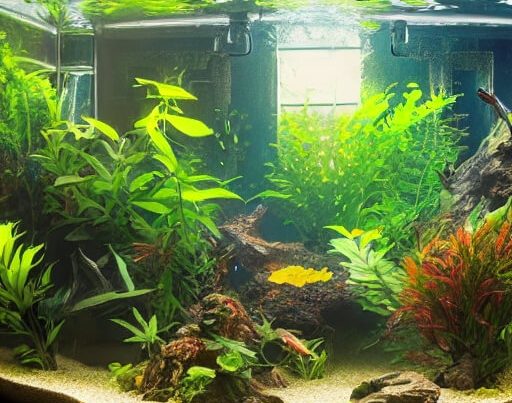Maintaining a clean and healthy fish tank is essential for keeping your fish happy and thriving. Cleaning the glass of the aquarium can be challenging, as it needs to be done regularly without damaging the tank in any way. To make sure that you are doing the job properly and safely, it is important to use the right materials for cleaning. This article will provide a list of options on what to clean fish tank glass with.

Cleaning Fish Tank Glass
Cleaning fish tank glass may be one of the most important maintenance tasks when it comes to keeping a healthy aquatic environment. Keeping your tank’s glass clean is essential if you want to create an attractive and healthy home for your fish. Fortunately, there are many products on the market that can make this task easy and safe for both you and your fish.
When cleaning fish tank glass, it is important to use materials that will not harm the water or any of the inhabitants in the tank. The best way to do this is by using specially designed aquarium cleaners specifically designed for this purpose. These cleaners tend to be milder than ordinary household cleaners, so they won’t damage your tank’s delicate systems or cause harm to plants and animals living within it.
Necessary Supplies for Fish Tank Glass Cleaning
Maintaining a clean fish tank is essential for the health of your aquatic inhabitants. Proper cleaning and maintenance of your fish tank glass will allow you to keep water quality high, while also preserving the beauty of your aquarium. To properly clean your fish tank glass, there are some important supplies that you need to have on hand.
- Glass Cleaner – Algae Pads and Magnetic Cleaners
- Towels and Cloths
- Scrubbing Sponges Replacement
- Scrapers and Scrubbing Brushes
- Vacuum or Gravel Cleaner
- Magnetic Algae Scraper
- Water Testing Kit
No doubt, an algae scraper is one of the most important tools you can have. An algae scraper can help remove stubborn buildup from the walls and other surfaces of your aquarium with ease. A sponge or microfiber cloth is also useful for wiping away dirt, debris, and large particles that get stuck on the glass surface.
Additionally, an acid-free aquarium cleaner should be used to thoroughly disinfect your tank before refilling it with fresh water and adding new inhabitants.
Steps for Cleaning Fish Tank Glass
Regularly cleaning the glass of your aquarium can help keep the water clear, ensure healthy living conditions for your fish, and make sure that you are maintaining a safe environment for them. Here’s a step-by-step process to help you get started with cleaning your fish tank glass in just 5 easy steps.
Cleaning a fish tank glass is an important part of keeping your fish healthy and happy. Here are the five steps you should follow:
1. Prepare the tank. Unplug all electrical equipment, like heaters and filters, before beginning any scrubbing or wiping down of the tank walls.
PS: After this has been done, fill up a bucket with warm water and add some aquarium-safe detergent or vinegar to it (if needed). Put on rubber gloves to protect yourself from any bacteria or dirt in the water. Remove the decorations, gravel, and any other items from the tank. This will make it easier to clean the glass without accidentally damaging anything.
2. Remove Algaes. Use an algae scraper or magnetic cleaner to remove any visible algae from the walls of your aquarium.
Here we should pay attention to:
- Be sure to move slowly and take time to scrape off any stubborn patches of algae.
- Focus on one area at a time until all of the glass is clean.
- Once all areas have been thoroughly scrubbed, use an aquarium vacuum and siphon out any remaining debris from the substrate in your fish tank’s bottom.
- Be sure to do this very carefully and slowly so as not to scratch or damage the glass.
3. Rinse off all of your cleaning tools with hot water to remove any dirt or debris.
4. Fill a bucket with warm water and a few drops of aquarium-safe detergent and mix until suds form. Dip a soft cloth into the mixture and wipe down the inside of the tank’s glass walls.
5. Rinse off all surfaces with clean water before replacing decorations, gravel, etc., back into your tank.
Dealing with Hard Water Stains
When it comes to keeping your fish tank clean, one of the most important tasks is removing any hard water stains that may have built up on your tank’s glass. Hard water stains can be a nuisance and make it difficult for you to clearly view the fish inside, but the good news is that they are removable. The key to cleaning hard water stains from your fish tank glass lies in using a few household ingredients.
To remove these stubborn marks and make your aquarium look as good as new, start by mixing equal parts white vinegar and distilled water together in a spray bottle. Spray this solution onto the stained areas of the glass then let it sit for several minutes before scrubbing with a sponge or cloth. You can even use citric acid instead of vinegar for extra strength if necessary!
Avoiding Soaps and Detergents
Cleaning the glass of a fish tank can be tricky, and you want to keep your fish safe by selecting the right cleaning products. Soaps and detergents should be avoided at all costs. Not only are they harsh on tanks and can potentially harm the inhabitants, but they also leave behind soapy residues that can affect water conditions.
Using some more natural alternatives is a great way to rid your aquarium of grime without risking damage or harm to its fragile ecosystem. Consider using vinegar, baking soda, or lemon juice as an effective cleaning solution instead of commercial soaps and detergents.
Vinegar is highly acidic which helps it cut through tough residue with ease; baking soda helps neutralize odors; lemon juice is both antibacterial and antifungal, making it perfect for removing stubborn algae from glass surfaces.
Cleaning Frequency
Keeping a fish tank clean is essential to the health of your aquatic friends. Cleaning frequency is one of the most important aspects of tank maintenance. At least once a month, make sure to use an aquarium-safe cleaning solution to wipe down the inside and outside of your tank’s glass walls, as well as any other surfaces in contact with water. Doing so will help keep algae growth at bay and reduce cloudiness in the water caused by bacteria and dirt buildup over time.
However, if you have lots of fish or plants in your aquarium that produce waste, you may need to clean them more often than once a month. Test your water regularly for signs of deterioration such as nitrate levels or pH balance to determine if additional cleaning is necessary. When tackling dirtier tanks, it’s best to use specialized tools like magnets or scrapers made specifically for aquarium glass cleaning.
Maintaining a Clean Tank
Maintaining a clean fish tank is essential for making sure your aquatic pet friends remain healthy and happy. While there are many products on the market that you can use to keep your tank in top condition, it’s important to remember that not all of them are suitable for every type of tank. In this article, we’ll be discussing what to clean fish tank glass with so that you can ensure your fishy friends stay safe and sound.
The most important aspect of keeping a clean aquarium is regularly changing the water. This should be done at least once a week, using an aquarium vacuum cleaner or siphon hose to remove any debris from the bottom of the tank.
Additionally, an aquarium filter will help keep things looking fresh by removing any unwanted particles from the water as well as providing oxygenation for your fishy friends.
Alternatives to Glass Cleaners
When it comes to cleaning aquarium glass, most people immediately reach for glass cleaner. However, there are alternatives that work just as well, if not better. Homeowners who want to make sure their fish tank is sparkling clean should consider these alternative methods of cleaning before resorting to traditional glass cleaners.
For starters, white vinegar is a natural and chemical-free way of getting rid of scum and algae on the inside walls of an aquarium. It’s important to dilute the vinegar before use in order to avoid harming any aquatic life within the tank.
For best results, mix one part white vinegar with five parts water before using a sponge or rag to apply it directly onto the surface. After this step is complete, rinse the area with warm water until all traces of vinegar have been removed.
Another method for cleaning fish tanks is by using baking soda paste.
Conclusion: Cleaned Glass Equals Healthy Fish
A cleaned glass equals healthy fish. A clean tank will help keep your fish safe and healthy, and in the long run, save you money. The key is to use a product that won’t harm your fish, while still doing its job effectively. Algae remover pads are an easy way to clean the glass on a regular basis without putting your fish at risk.
Cleaning agents made especially for aquariums are also available but should only be used sparingly as they can be quite toxic to both the water and any living creatures inside the tank. Regular cleaning of your tank’s glass will ensure that your fish live longer and happier lives, free from pollutants or dangerous chemicals.




